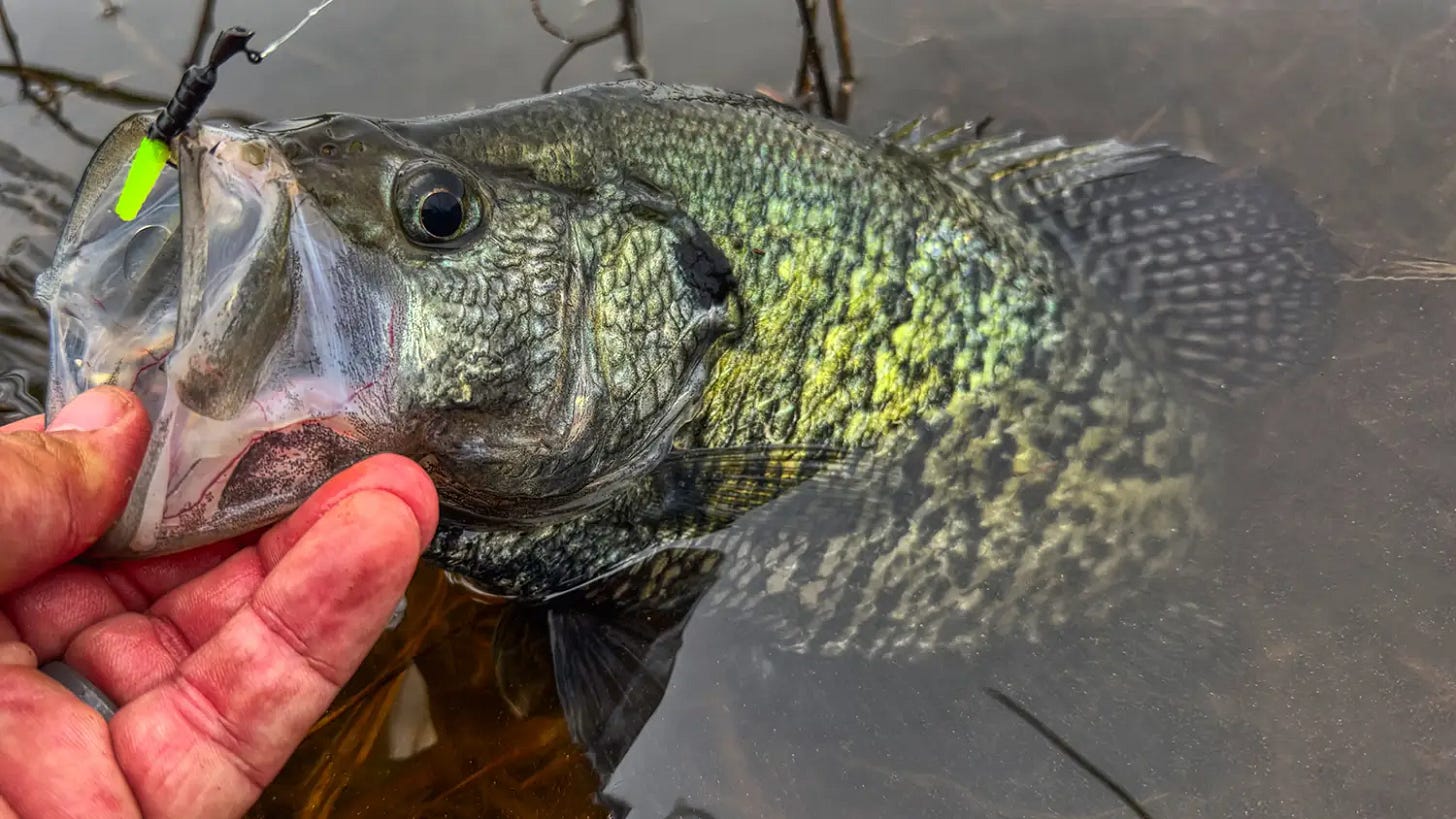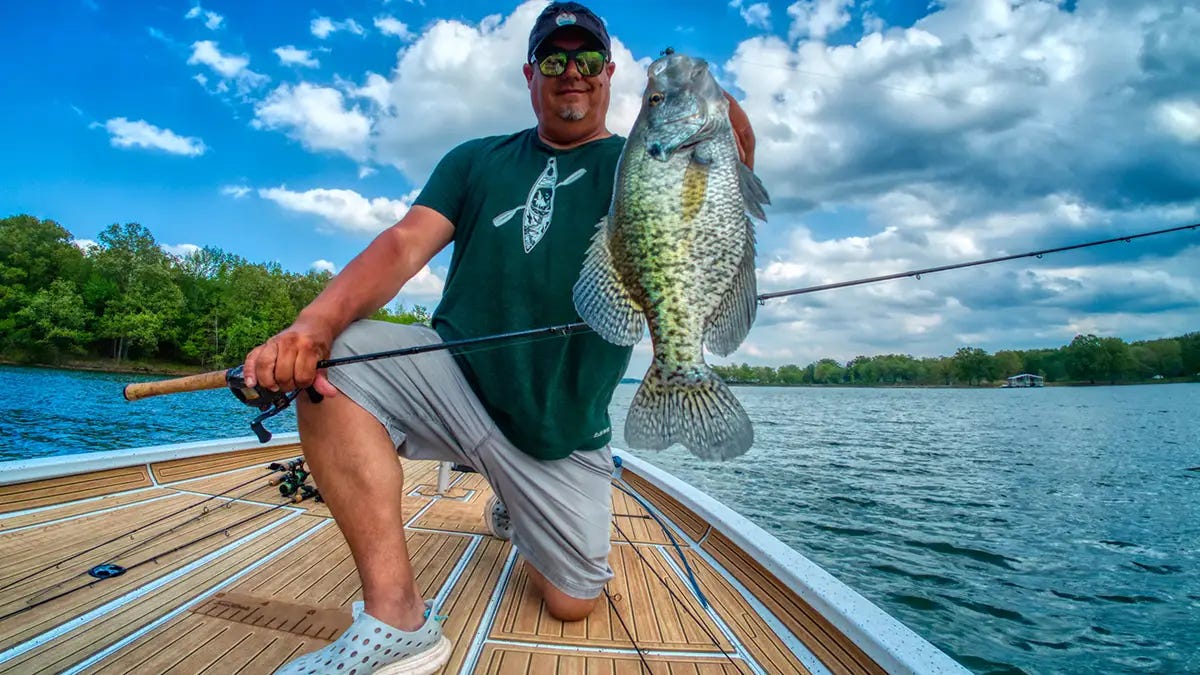Corking Crappie Off the Bank
Talking about the best approach to catching crappie while they are on the banks
Crappie fishing offers one of the more rewarding ways to fish in the spring. You can get into a lot of fish in small areas, they come shallow and are a bit easier to get to and they are usually aggressive in the spring. And there is something rewarding about having a mess of crappies in the livewell to provide supper for the family.
The month of April is often when crappies move shallow to spawn and is one of the most eagerly anticipated bites of the year. Lakes like Kentucky Lake are absolutely covered with anglers in April chasing big crappies and limits of '“eater-sized crappie” en masse.
But for me, I long for that small window where we can just go down the back casting and winding and catching crappie just fishing. One of my favorite ways to catch crappie is corking. Or simply just slow twitching or reeling a light crappie jig under a float. We cork to keep the lure above the cover and crappie so that we can work the jig ultra slowly through likely feeding and spawning banks.
It’s hard to beat a jig and float combo when the crappie are on really shallow cover and you can’t get close to them without spooking them. Just casting a jig and reeling usually means you have to reel too fast to keep it off bottom. But the float allows you to suspend the jig and keep it above or in the strike zone and in the crappie’s face longer.
HOW TO CORK THE BANKS
Corking for crappie is really easy. And that’s probably why I love it so much. People tend to think I’m a super cerebral analytical angler because my career in IT and website and media has involved a lot of technology, algorithms and the like. But really what I am is a person who tries to perfect systems to simplify everything. So when I can make fishing simple, I always gravitate towards that.
So simply clipping a float onto your line a few feet above a jig doesn’t get much simpler to me. Especially when coupled with the fact that your retrieve as equally as simple. I don’t view bobbers as indicators. I view them as suspenders. I want to work my jig slowly above the fish and cover. And a float allows me to do that more efficiently. Because I can use a little heavier jig, and float and cast a lot farther while still keeping my presentation up in the water column above the snags and fish.
You can vary your retrieve. You can slow and steady wind your jig back, trying not to make the float dimple the surface to much. Ultra stealthy. You can pull and stop it which causes the jig to rise and fall in the water column. You can twitch and reel giving it an undulating action under the water. You can pop it and let it sit. Often I do all of these things until I find a way that gets the most bites.
If I’m fishing water that is four or five feet. I will start with the float maybe 2 feet above the jig. My hope is I reel it by a big rock, stump or piece of cover that a fish may be using to spawn or ambush food. This is also super effective around grass. Around grass I often just move the jig a few inches and stop and repeat this all the way back.
BENEFITS OF CORKING SHALLOW CRAPPIE
What you can do with a jig and float allows you to be more precise in your presentation. I can keep my jig around a fish a lot longer than just throwing out and reeling back in. And that is a big deal in the spring. Crappie get very “home base” oriented in the spring. They will not venture out far from the cover or bed so you want your jig there taunting them as long as possible.
I can also vary my retrieve a lot with a float which helps me get more bites. Because I can cater to the mood of finicky spawning fish. Sometimes they are super aggressive and its easy. Sometimes they want to know it’s alive but not move too far too fast. I believe more crappie are NOT caught because of speed than anything else. You simply are fishing your jigs too fast.
But when you are casting and trying to stay out of the cover and the bottom, you have to keep the jig moving. You can go down in weight but then you severely limit your casting distance. So, for me, a float fixes all of that. I can now throw farther, fish slower, add longer pauses and still be in the fishes strike zone.
ADVANCED TIPS FOR FLOAT FISHING CRAPPIE
The one draw back is when you want to target fish in water deeper than about 5 feet. Then you start needing longer rods, or slip floats to be effective with a bobber and it gets infinitely harder.
For this I borrowed from the Trout Magnet playbook. I got one of their 9 foot trinity rods. I can fish a fixed EZ-Float nine feet deep with this setup and still be able to cast it. So I get a lot more range now with my float fishing.
I prefer a fixed float. The Panfish Magnet E-Z Float is my go to float. And soon we can get them in bulk packs. You simply set your float by pulling the pin, sliding your line into the slot and then pinch it in place by pushing the pin back in. Doesn’t hurt your line and stays fixed through a handful of hooksets before needing adjusted again.
You can also add a couple split shot under the float to give you a little better casting distance. Just make sure the EZ Float suspends your jig and split shot appropriately.
The E-Z Float stands up when the jig is suspended under it. When the jig is on bottom, the float lays on its side. So you can be sure what is going on as you fish.
I can get really finessy with my jigs with a float. So I can down size a lot if the fish are uber finicky in clear water. That’s a big benefit too. I catch a lot of crappie on hand tied jigs and bugs. And some of those are 1/32 ounce or lighter. Something I would struggle to cast without a float.
RECENT EXPERIENCES FLOAT FISHING JIGS
I have been catching some nice crappie off the banks this spring. And one thing I’ve found in common is the types of banks. If you can find banks with a little slope that flatten at the bottom of the slope and also have hand sized to head sized chunk rock on them and/or stumps mixed in, you will be in a high probability area for crappie fishing on the banks.
It seems like banks with gravel mixed in with that bigger medium chunk rock and a little wood along them are the best probability indicators for crappie on the banks.
A small lake I sometimes fish in Arkansas has a lot of bank grass and the crappie like to use those edges to spawn and feed just before the spawn. So again I’m looking for something about those banks that will put the fish there.
I am pretty good with my electronics and I often find I don’t see the crappie on these chunk rock banks. But as I fish them they will appear out of the bottom or the sporadic cover along the bottom. These fish are usually hunkered down and don’t show themselves until the jig comes floating over.
The other bonus thing I have been catching with this approach is jumbo prespawn bluegills and shellcrackers also using the rocks and stumps to find food before they spawn later in the year. So I have been taking a couple different cork rods. One with a bait like a Crappie Magnet it on it. And another with a hand-tied bug or smaller Panfish Magnet on it on a smaller No. 8 hook jighead. That way I have a higher catch rate on big gills and crackers that are also on these banks. And the big crappie still bite those small bugs.
MY FAVORITE JIGS FOR CORKING CRAPPIE
I bounce around between a few offerings. I like something that looks natural under the float just sitting there and something that looks good being swam or twitched along. I’m a big fan of both Crappie Magnets and Trout Magnets. I also like the new Nano Snack from American Baitworks. I will also use some hand tied jigs and just about any shad profile type plastic on occasion. But day in and day out, it’s a Crappie Magnet or Trout Magnet to start and work out from there.
I usually have a jig rod with a swimmer on it like a Charlie Brewer Slider or American Baitworks Nano Swim on it. And then a couple corking rods with different sized offerings on them when I am bank fishing for crappie. That way I cover the bases with straight swimming for aggressive fish, slower retrieves for home body fish, and smaller profiles for weary finicky fish.
If' you’ve not tried casting the banks for crappie, this is the time to go do it. I highly recommend it as a simple and fun way to crappie fish this time of year.








